Creating unmatched shopping experiences is the primary mission of any ecommerce business owner. In the pursuit of a steady flow of customers, merchants introduce diverse shopping benefits, such as discounts and promotions, to make purchasing even more satisfying. One of the possible ways to achieve this is by creating shopping cart rules.
We’ve compiled the guide to creating shopping cart rules in Adobe Commerce (formerly known as Magento) to help you make your discount system work seamlessly.
What Are Shopping Cart Rules?
Shopping cart price rules are the admin regulations dealing with discounts. They can be used after entering a coupon/promo code. An ecommerce website visitor will see the Apply Coupon button after adding products to a shopping cart and the discount amount under the subtotal price bar.
Where to start?
Creating or editing shopping cart price rules with Magento is pretty easy, in case you know where to go first.
- After logging into your admin dashboard, find the Marketing bar in the vertical menu.
- In the top left corner, you’ll see the Promotions unit, covering catalog and cart price rules. Go for the latter one.
Add A New Cart Rule
- Tap the Add New Rule button and get ready to fill in the core discount information in a couple of fields:
- Rule Information,
- Conditions,
- Actions,
- Labels,
- Manage Coupon Codes.
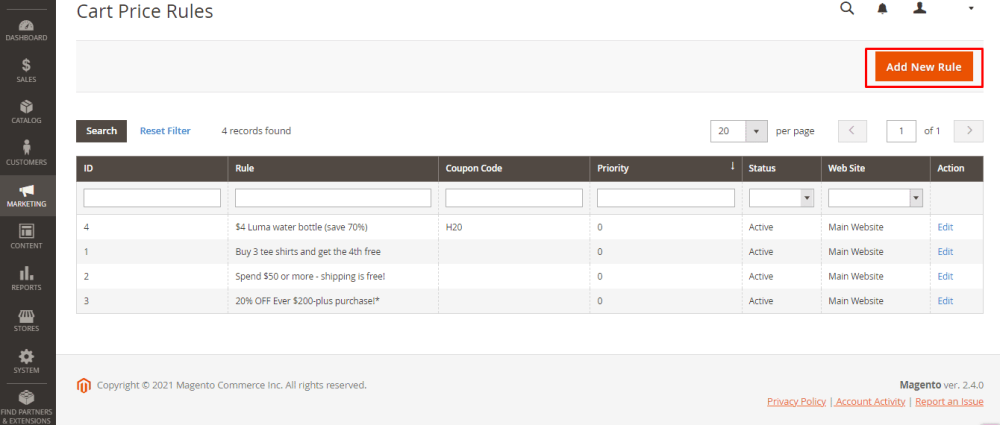
Filling In The Rule Information
Here you are to fill in a number of typebars.
- Start with Rule Name and add a short description of it. The Description field will only be seen on the Admin page not to abuse clients with excessive details and save those for yourself.
- Enable the cart price rule by tapping the switch below.
- In the Website section, you are to insert the website where the new rule will be activated.
- Then goes the selection of Customer Groups, eligible for the discount. Mind that you can easily attach a new customer group if you can’t find the appropriate option in the drop-down menu.
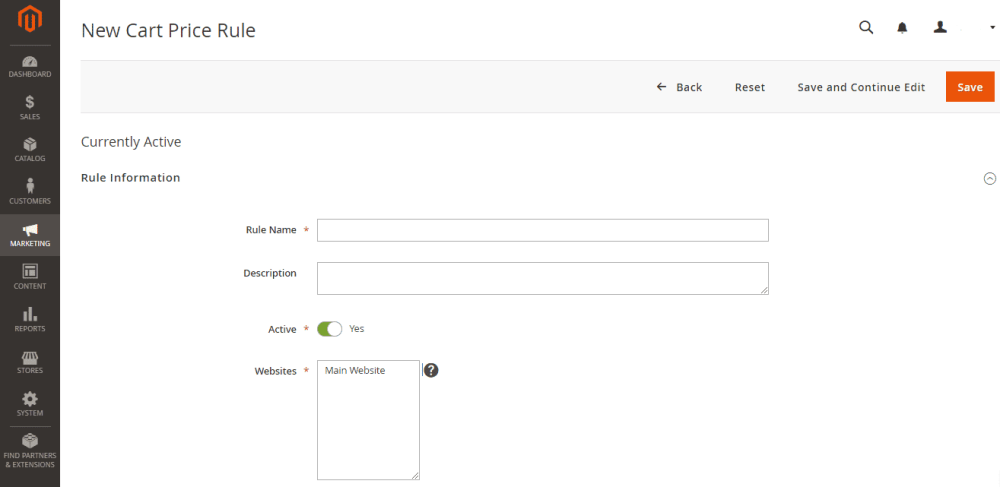
Completing the Coupon section
While creating shopping cart rules in Magento, you can either go for the No Coupon option or choose a Specific Coupon setting.
No Coupon
- Fill in the Uses per Customer field, defining how many times the same buyer can apply the rule.
- Select the initial and expiry dates for the rule to limit the period of lower price tag availability
Specific Coupon
- Enter the coupon code.
- Insert the figures for Uses Per Coupon and/or Uses Per Customer to ensure the rule is not overvused.
Another point to pay attention to is the coupon auto-generation option, which makes it possible to create various coupon codes after filling in an additional section of Manage Coupon Codes described below.
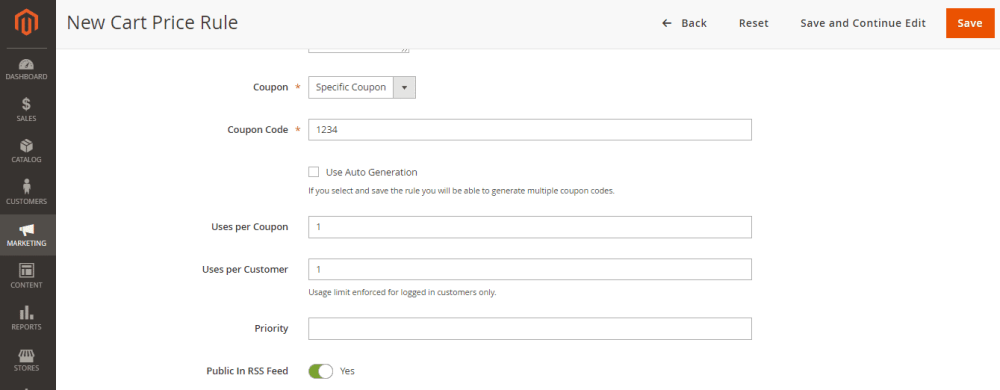
Setting The Rule Conditions
- In the following section, you are to set the basic conditions under which the rule will be applied. If you want to set specific shopping cart conditions, you can edit the If all of these conditions are true sentence by choosing other options than all and/or true.
- Click the Choose a condition to add tab to see the drop-down statements menu. In case a single condition statement is insufficient, feel free to add as many as you need. If the rule should be applied to all the products, just skip the step.
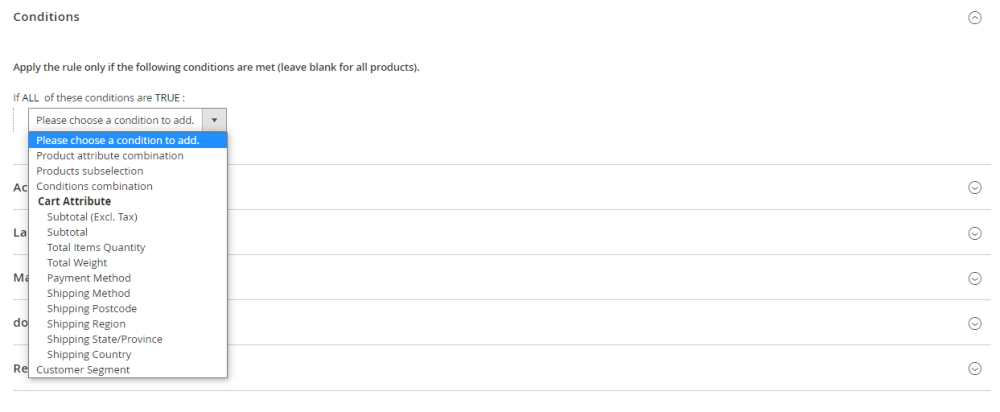
Defining The Shopping Cart Rule Actions
By actions, shopping cart rules in Magento imply the type of discount calculations. For instance, you can choose between Percent of product discount, Fixed Amount Discount, Fixed amount Discount for the whole cart, or Buy X get Y variant.
- Select the appropriate option in the Apply tab drop-down menu and insert the amount of discount together with the number of products a buyer has to put in a cart to use the cart price rule.
- The next switch can enable adding a discount either to subtotal or to the shipping price.
There are two more fields left.
- The Discard subsequent rules mean that other rules with smaller discount amounts will or won’t be applied to buyers’ carts.
- Finally, you can fill in the Conditions tab by defining particular products applicable to the discount or leave it open for the whole catalog.
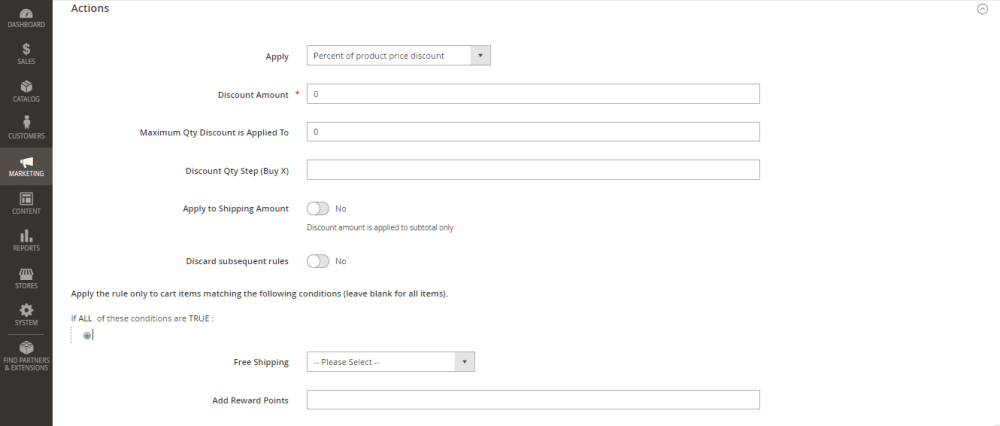
Labeling Shopping Cart Price Rules
- Set the Label section if you manage a multilingual store.
The Label section is relevant for those who run a multilingual ecommerce store since it allows displaying the label text in different languages. If your store is monolingual or you don’t want to bother with entering different label texts for each view, you should select to display a default label.
But using a single language is a real con, limiting the client scope and decreasing the level of their online shopping experience. So if your ecommerce is not language-friendly yet, take your time to make amendments. And then create the rule label as a translation reference.
About Managing Coupon Codes
- If you decide to enable coupon code automatic generation, you’ll have to add some more specific coupon details to this section. Insert the coupon quantity, length, format, code prefixes/suffixes, and dashes in the appropriate tabs and tap the Save rule button.

- Congratulations, you are through with the task.
TIP: Once you create one cart rule, you’re likely to create a few others to make your discounts even more personalized. To be able to navigate through them, you can filter the rules out by columns, edit them, or simply look through the rule info.
Shopping cart rules are one of Adobe Commerce’s Magento 2 features that will help you easily create benefits for your customers without writing a line of code. By following the above-described steps, you’ll be able to make your ecommerce store a better fit for ever-rising customer demands, attract new customers via spreading coupon codes among niche influencers and enhance your general marketing strategy.
© 2021 DK New Media, LLC, All Rights Reserved

